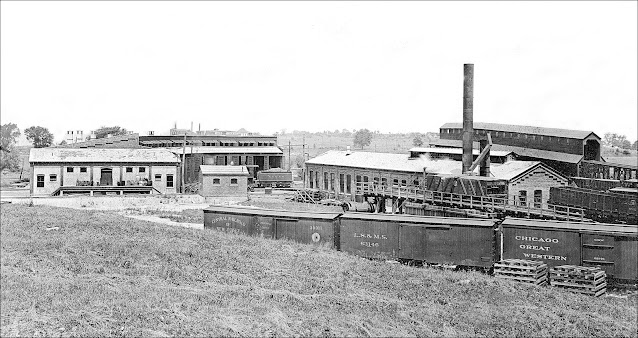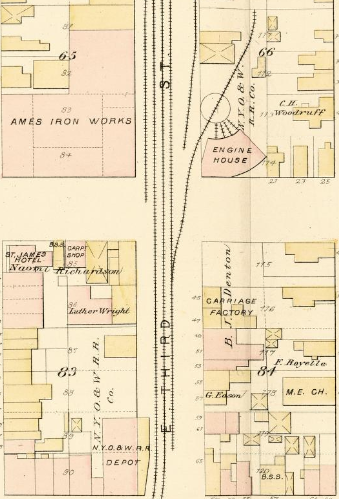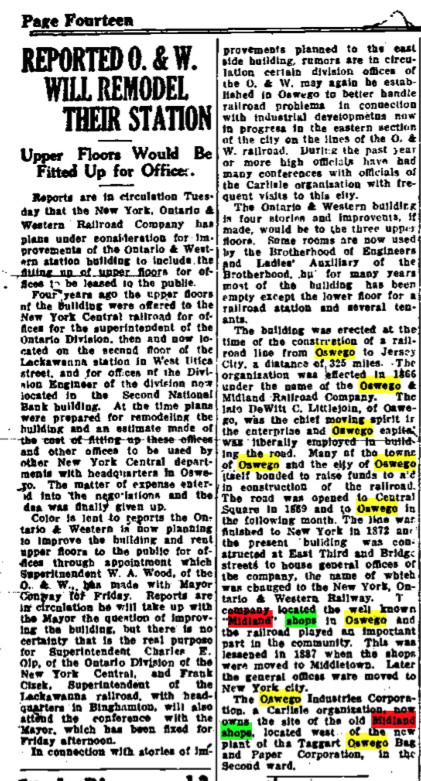Oswego Advertiser & Times
Friday, August 20, 1869
The Midland Passenger Depot
It has been advertised for several days that plans, specifications, etc. for the Midland Passenger Depot, and other buildings to be located in this city might be examined at the Engineers office here and today they arrived and are now open for the use of contractors, builders, etc. A brief description of this depot may be of interest not only to builders, but to the public at large.
The depot is to be an imposing structure, located along East Bridge and Third street, fronting on Third. The plan for the main building is one hundred feet on Third, by sixty-five on Bridge, exclusive of an arch-way from Bridge street, ten feet wide for a drive way. The building is to be three stories high with a Mansard, or French roof. A covered verandah, seventeen feet wide, is to skirt the building upon Third and Bridge streets.
The Grand Plan
Upon the first floor are situated the gentlemen’s room 52x29 feet, ladies; room 42x25 feet, baggage room 42x21 feet, together with the ticket and telegraph offices, closets, etc.
Second Story
On the second floor are located the general offices of the company. It is divided by a hall six feet wide running the entire length of the building. On the east side of this hall commencing on the Bridge street corner of the building are located the Superintendent’s, Engineer’s, General Ticket and Secretary’s Offices, 28x1, 24x16, and 21x17 feet respectively.
Adjoining the President’s office, on the south is the Treasurer’s office, 24x17 feet, with a fire and burglar proof vault attached,12x10 feet.
Fronting on Bridge street, occupying the south-west corner, are three freight offices, 28x17, 19x13 and 19x13 respectively.
The third floor is to be occupied as conductor’s rooms, accommodations for local employees, etc.
The building is to be of brick, substantially built, and of tasteful style of architecture, and will be an ornament to the city.
The plans and specifications of this depot together with the same for other buildings to be located here may be examined for a few days, in the engineer’s office in the ADVERTISER Building, where builders will find Mr. Harris, the gentlemanly engineer in charge, ready got furnish information in his power.
The erection of the buildings will give employment to many mechanics and laborers during the fall and coming winer and we trust some of our own enterprising builders will be fortunate enough to secure the contract or contracts.
A large number of men and teams are at work running the Midland up East Third street; andthe contract for work-shops and round-houses has been awarded to Marshall & Barnes - the depot contract to Gibbs and Rogers.
Oswego Advertiser and Times
Wednesday, November 10, 1869
FIRST PASSENGER COACH ON THE MIDLAND. -The locomotive “Oneida,” with the Paymaster’s car, arrived here at 7:45 last evening with Mr. R. W. Ware, Division Engineer, Mr. A. S. Bridgeman and Messrs. W. H. and H. W. Weed as passengers.This was the first passenger coach that has yet arrived at Oswego over the Midland. But should the weather be favorable it will be but a short time before this thing is no longer a novelty, for passengeer trains will be coming and going daily. The train left this morning at 10 o’clock for Oneida. It brought “stamps” and rejoicings to the hearts of laborers along the line.
Oswego Daily Advertiser and Times
Wednesday, Nov. 24, 1869
Midland Trains. - Tomorrow morning at 7:30 a.m. the first train of passenger coaches on the New York & Oswego Midland R.R., will start from the depot being erected in this city.
By the timetable published among our advertisements, it appears that two trains will leave and arrive daily - leaving at 7:30 a.m. and 4 p.m., and arriving at 2 p.m. a and 9:30 p.m. The morning train reaches Fulton at 8:10, and Oneida at 10:50, connecting with the New York Central trains east and west, and arrives at Norwich at 1:30 p.m. The afternoon train arrives at Fulton at 4:40 p.m., Oneida at 7:20, and Norwich at 10 p.m.
Oswego Daily Advertise and Times
Thursday, November 25, 1869
First train over the Midland. - As we announced the first passenger train over the Midland left the new depot building at 7:30 for Norwich, The train consisted of three large and beautiful coaches, a large and commodious smoking and baggage car, drawn by the powerful locomotive Fulton, the whole under the direction of Conductor Folks.
Accompanying the train was President Littlejohn, Superintendent Day and others prominently connected with the enterprise, and others. A large number of citizens also were on hand to make the first trip over the Midland.
Oswego Advertiser and Times, Monday, January 3, 1870
Midland Telegraph. - On Saturday last, the first day of the new year, the telegraph line operated on the Midland Railway was opened to the public for dispatches.
Offices are now being established at the principal points the line between Oswego and Norwich, with ample facilities for doing commercial as well as railroad business, and at Oswego and Oneida connections will be made for all points East and West on commercial lines.
The line has been put under the supervision of W. H. Weed, Superintendent of the Telegraphic Department, and is built in a most substantial manner and of the best material, insuring prompt and reliable transmission of telegrams. This line opens a long sequestered region of country to the advantages of the telegraph, as the Midland does the same country to the advantages of railroad business,
In the newspaper business we have frequently, in truth, almost incessantly experienced the requirements of telegraphic communication with the central towns of Oswego county, which this line now furnishes.
Oswego Daily Times, September 3, 1870
The Midland Locomotive an Car Works
___
The Shops in Operation
___
Getting Out an Order For Fifty Cars
___
The headquarters of the New York and Oswego Midland Railroad Company are to be in this city, and, with this in view, the company have been building extensive works and a depot, containing rooms for the head offices.
The shops are located near the shore of Lake Ontario, in the Second ward. The car shop is of brick, 360x80 feet, and has just been finished. The west part is used as a wood shop, which is 140x80 feet, and is already in operation and engaged in turning out an order for fifty coal cars. It is already provided with considerable machinery - all, in fact needed for present purposes in order to turn out work in a labor-saving manner.
The lumber is planed, mortised, and the tenons cut by machinery, and it then goes to a gam cutter, invented by Mr. Griggs, the Master Mechanic, which does the last of the heavy work required to fit the timbers of a car for framing. The machinery is run by an engine of twenty horsepower, which, however, will ultimately make way for one of 70 horsepower.
Above the wood shop is the patter shop with the machinery necessary for that important part of the business. We noticed here a very handsome and perfect lathe from the New York Steam Engine Company’s Works at Worcester.
Adjoining the wood shop is an immense room, 220x80 feet, to uses as the locomotive works. The machinery is not yet ordered for this department, which probably will not be put in operation till another year, the works in the round house being ample for present requirements. Nine tracks run into this immense machine shop, connecting with a great transfer table 22 feet long and 28 feet wide, which adjoins the round house. Mr. Gregg’s office, with that of this clerk, is to be in the locomotive works.
The round house which was built last year, is 167 feet in diameter and contains 20 stalls. It is now used as a machine shop for the repair of locomotives and making the iron work for the cars. Thee is already some valuable machinery here, from the famous establishment of William Sellars, Philadelphia, from which comes some of the most perfect machinery in the country.
We noticed a ponderous “punch” which, operated by two mechanics, was punching holes through a bar of seven-eighths inch iron with heat equanimity. Also a hydraulic press, for pressing on the wheels of locomotives, which is capable of making a squeeze of 7,000 pounds to the square inch, or a total pressure of 125 tons - more than is eve requisite, however. It presses on both wheels at once. This is from the Fairbanks Foundry and Machine Works at Taunton, Mass.
There are yet to be built a round house for setting up locomotives, a blacksmith and boiler shop 14 feet long, and a large brass foundry and tin shop. They are turning out fifty coal cars and two immense snowplows, and a third plow will be built before snow flies.
The equipment of the road now consists of 22 locomotives, 12 coaches, 9 baggage cars, 3 mail and smoking cars and 335 freight cars. Mr. Griggs had on his August pay roll 138 men, which include the whole line. Between 50 and 60 mechanics are now employed in the Oswego shops.
The management of these shops is in competent hands. Mr. Griggs has the general oversight and direction of the works. Mr. T. D. Day, from the Rome shop, is foreman of the machine shops. The location of these buildings in the Second Ward will add material to the prosperity of that section.
Oswego Daily Press, September 21, 1870
The New Midland Depot
____
It Stands Ready for Occupation
____
The large, handsome, and substantial building put up by the Midland R.R. Co. , corner of East Third and Bridge streets in this city, for a depot and the general offices of the Company, is now finished and awaiting its occupants.
Superintendent McKinley is moving in his furniture, and the Company's office is expected will be moved here from Oneida without delay. The building is brick, three stories high, with a cellar under the whole, and is a conspicuous landmark on the East side.
Ground Floor.
On the first floor, south end, is the gentlemen's waiting room, running entirely through from east to west and with entrances on Bridge and Third streets. Adjoining this on the north side is the ladies' waiting room, which is frescoed and neatly finished. Between the two is the ticket office, very conveniently arranged and commodious. Next north come the express room, baggage room, and freight office, from which baggage and freight may be thrown in and taken through to the cars in front, making the transfer very easy.
Second Floor.
A hall runs through the centre of the building, second floor, from north to south. In the southeast corner is a suite of rooms for the Superintendent; next north is the General Road Master's office; next the general telegraph office, and still next the general ticket office. In the southeast corner, west side of the hall, is the President's room; next, the Secretary's office; next, a large room with rows of desks for the Secretary's corps of clerks, adjoining which is a large fie proof vault built up from the floor. Next north are two rooms for the Civil Engineers. The offices and rooms on both floors are all large and elegantly furnished. The wainscoting and floors are of black ash, finished in oil, and the walls are hard finished in oil, and the walls are hard finished. The rooms are provided with wash and water closets, and other conveniences.
The Builders.
The mason work was done by John Smith & Co.; woodwork by Gibbs & Rogers; painting and graining by Skinner & Co.; gas fitting by John O'Geran, and plumbing by E. Canfield. We believe the contract price was about $34,000, though on this point we have not positive information.
Oswego Advertiser & Times
September 24, 1870
THE MIDLAND RAILROAD OFFICES
There has been considerable delay on the part of the mechanics in getting ready the Midland Railroad offices for occupation in this city, mostly we think in regard to the furniture. We took a hasty look through the various offices a day or two since and were particularly pleased at their commodiousness and the taste displayed in the finish.
In this work black Ash has been used for floor, doors, casings, etc., and one who has not seen the premises will be surprised mat the beauty of the this matched. We found the enterprising Superintendent Col. McKinley already occupying commodious quarters, with the others apparently ready for permanent residence.
While there is no apparent extravagance about these offices, they are evidently on a scale demanded by the business of a great Road, such as the Midland is to be, and are a credit to those who designed and those who built an d finished them, and an ornament to the city,
We would advise our business men and citizens generally to take a look through these offices, as we presume Col. McKinley will received them with courtesy and show them through. At events he did us, and it is “just his way.”
Since wiring the above we have been shown a circular under age of Sept. 22, which states that: “The General office of this Company will be removed from Oneida to Oswego on Tuesday, the 29th inst., except the Treasurer’s Office, which will be continued at Norwich as heretofore.
“All communications to the President, Superintendent, Chief Engineer, Resident Engineer, Roadmaster, Secretary, General Ticket Agent and General Freight Accountant, will be forwarded to Oswego after that date.
D. C. LITTLEJOHN, President.”
Recollections of the New York, Ontario & Western Station in Oswego
[Jay Knox, a columnist for the Oswego Palladium-Times, wrote on March 26, 1946:]
“The Wabash Flyer would lay over for three or four hours, while it was being shifted to the R.W. & O. tracks, and would leave over the Hojack the next morning around 4 o'clock and often later. The train was always greeted by large groups of people.
"Those emigrants were a happy lot and many of them would be bound for states as far west as Idaho, Nevada and California. Most of them were Germans; and a majority of them were seeking homes in Detroit, Chicago and Minneapolis - and other cities.
“They used to leave quite a little money with the eating house near the station. After a period of years the Wabash Flyer was re-routed and became almost forgotten as far as Oswegonians were concerned.
"Well do we recall the time when we stayed up all night in order to take the train at 4 o’clock, only to learn that it was three hours late. And probably that is where we got our reputation for being ‘night hawks.’ It then proceeded across the river to make a stop at the New York Central station."
Oswego Palladium Times
Friday, June 28, 1929
Gasoline Car on O. & W. Discontinued*
____
But One Train a Day Each Way to be Operated
Starting Friday the gasoline motor car, operating between Norwich, Oneida and Oswego and return will be discontinued by the New York, Ontario and Western railroad.
Discontinuance of the train leaves but one each way, daily and Sunday.
The milk train for the south carrying passengers will leave at 6:50 a.m. daily and arrive at 9:22 a.m. daily. Trains discontinued left at 1:40 p.m. daily except Sunday and arrived at 6 p.m. daily except Sunday.
Whether the railroad company will restore the trains in the fall has no been determined. Increasing use of automobiles has worked havoc with patronage of seam trains in the last few years. The decrease was especially noticeable this spring.
A few years ago, the O. & W. had three trains each way, including specials to Sylvan Beach. Gradually the patronage dwindled. he specials were removed, later the passenger and milk trains were combined.
*Gasoline car #801 put in service between Norwich and Oswego on Trains #41 and #42, June 25, 1925. Shuttle from Oneida Castle to Sylvan Beach discontinued August 18, 1926.




















